| Listing 1 - 10 of 27 | << page >> |
Sort by
|
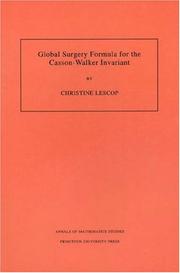
ISBN: 0691021333 1400865158 9781400865154 9780691021331 0691021325 9780691021324 Year: 1996 Volume: 140 Publisher: Princeton, New Jersey : Princeton University Press,
Abstract | Keywords | Export | Availability | Bookmark
 Loading...
Loading...Choose an application
- Reference Manager
- EndNote
- RefWorks (Direct export to RefWorks)
This book presents a new result in 3-dimensional topology. It is well known that any closed oriented 3-manifold can be obtained by surgery on a framed link in S 3. In Global Surgery Formula for the Casson-Walker Invariant, a function F of framed links in S 3 is described, and it is proven that F consistently defines an invariant, lamda (l), of closed oriented 3-manifolds. l is then expressed in terms of previously known invariants of 3-manifolds. For integral homology spheres, l is the invariant introduced by Casson in 1985, which allowed him to solve old and famous questions in 3-dimensional topology. l becomes simpler as the first Betti number increases. As an explicit function of Alexander polynomials and surgery coefficients of framed links, the function F extends in a natural way to framed links in rational homology spheres. It is proven that F describes the variation of l under any surgery starting from a rational homology sphere. Thus F yields a global surgery formula for the Casson invariant.
Chirurgie (Topologie) --- Drie-menigvuldigheden (Topologie) --- Heelkunde (Topologie) --- Surgery (Topology) --- Three-manifolds (Topology) --- Trois-variétés (Topologie) --- 3-manifolds (Topology) --- Manifolds, Three dimensional (Topology) --- Three-dimensional manifolds (Topology) --- Low-dimensional topology --- Topological manifolds --- Differential topology --- Homotopy equivalences --- Manifolds (Mathematics) --- Topology --- 515.16 --- 515.16 Topology of manifolds --- Topology of manifolds --- 3-manifold. --- Addition. --- Alexander polynomial. --- Ambient isotopy. --- Betti number. --- Casson invariant. --- Change of basis. --- Change of variables. --- Cobordism. --- Coefficient. --- Combination. --- Combinatorics. --- Computation. --- Conjugacy class. --- Connected component (graph theory). --- Connected space. --- Connected sum. --- Cup product. --- Determinant. --- Diagram (category theory). --- Disk (mathematics). --- Empty set. --- Exterior (topology). --- Fiber bundle. --- Fibration. --- Function (mathematics). --- Fundamental group. --- Homeomorphism. --- Homology (mathematics). --- Homology sphere. --- Homotopy sphere. --- Indeterminate (variable). --- Integer. --- Klein bottle. --- Knot theory. --- Manifold. --- Morphism. --- Notation. --- Orientability. --- Permutation. --- Polynomial. --- Prime number. --- Projective plane. --- Scientific notation. --- Seifert surface. --- Sequence. --- Summation. --- Symmetrization. --- Taylor series. --- Theorem. --- Topology. --- Tubular neighborhood. --- Unlink.
Book
ISBN: 1283379961 9786613379962 1400842700 9781400842704 9781283379960 9780691153308 9780691153315 0691153302 0691153310 Year: 2012 Publisher: Princeton ; Oxford : Princeton University Press,
Abstract | Keywords | Export | Availability | Bookmark
 Loading...
Loading...Choose an application
- Reference Manager
- EndNote
- RefWorks (Direct export to RefWorks)
Convolution and Equidistribution explores an important aspect of number theory--the theory of exponential sums over finite fields and their Mellin transforms--from a new, categorical point of view. The book presents fundamentally important results and a plethora of examples, opening up new directions in the subject. The finite-field Mellin transform (of a function on the multiplicative group of a finite field) is defined by summing that function against variable multiplicative characters. The basic question considered in the book is how the values of the Mellin transform are distributed (in a probabilistic sense), in cases where the input function is suitably algebro-geometric. This question is answered by the book's main theorem, using a mixture of geometric, categorical, and group-theoretic methods. By providing a new framework for studying Mellin transforms over finite fields, this book opens up a new way for researchers to further explore the subject.
Mellin transform. --- Convolutions (Mathematics) --- Sequences (Mathematics) --- Mathematical sequences --- Numerical sequences --- Algebra --- Mathematics --- Convolution transforms --- Transformations, Convolution --- Distribution (Probability theory) --- Functions --- Integrals --- Transformations (Mathematics) --- Transform, Mellin --- Integral transforms --- ArtinГchreier reduced polynomial. --- Emanuel Kowalski. --- EulerАoincar formula. --- Frobenius conjugacy class. --- Frobenius conjugacy. --- Frobenius tori. --- GoursatЋolchinВibet theorem. --- Kloosterman sheaf. --- Laurent polynomial. --- Legendre. --- Pierre Deligne. --- Ron Evans. --- Tannakian category. --- Tannakian groups. --- Zeeev Rudnick. --- algebro-geometric. --- autodual objects. --- autoduality. --- characteristic two. --- connectedness. --- dimensional objects. --- duality. --- equidistribution. --- exponential sums. --- fiber functor. --- finite field Mellin transform. --- finite field. --- finite fields. --- geometrical irreducibility. --- group scheme. --- hypergeometric sheaf. --- interger monic polynomials. --- isogenies. --- lie-irreducibility. --- lisse. --- middle convolution. --- middle extension sheaf. --- monic polynomial. --- monodromy groups. --- noetherian connected scheme. --- nonsplit form. --- nontrivial additive character. --- number theory. --- odd characteristic. --- odd prime. --- orthogonal case. --- perverse sheaves. --- polynomials. --- pure weight. --- semisimple object. --- semisimple. --- sheaves. --- signs. --- split form. --- supermorse. --- theorem. --- theorems.
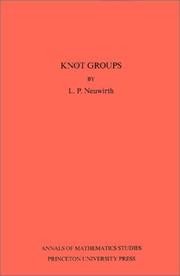
ISBN: 0691079919 1400882036 9780691079912 Year: 1965 Volume: 56 Publisher: Princeton (N.J.): Princeton university press,
Abstract | Keywords | Export | Availability | Bookmark
 Loading...
Loading...Choose an application
- Reference Manager
- EndNote
- RefWorks (Direct export to RefWorks)
The description for this book, Knot Groups. Annals of Mathematics Studies. (AM-56), Volume 56, will be forthcoming.
Topology --- 512 --- Algebra --- 512 Algebra --- Knot theory. --- Knots (Topology) --- Low-dimensional topology --- Abelian group. --- Alexander duality. --- Alexander polynomial. --- Algebraic theory. --- Algorithm. --- Analytic continuation. --- Associative property. --- Automorphism. --- Axiom. --- Bijection. --- Binary relation. --- Calculation. --- Central series. --- Characterization (mathematics). --- Cobordism. --- Coefficient. --- Cohomology. --- Combinatorics. --- Commutator subgroup. --- Complete theory. --- Computation. --- Conjugacy class. --- Conjugate element (field theory). --- Connected space. --- Connectedness. --- Coprime integers. --- Coset. --- Covering space. --- Curve. --- Cyclic group. --- Dehn's lemma. --- Determinant. --- Diagonalization. --- Diagram (category theory). --- Dimension. --- Direct product. --- Equivalence class. --- Equivalence relation. --- Euclidean space. --- Euler characteristic. --- Existential quantification. --- Fiber bundle. --- Finite group. --- Finitely generated module. --- Frattini subgroup. --- Free abelian group. --- Fundamental group. --- Geometry. --- Group ring. --- Group theory. --- Group with operators. --- Hausdorff space. --- Homeomorphism. --- Homology (mathematics). --- Homomorphism. --- Homotopy group. --- Homotopy. --- Identity matrix. --- Inner automorphism. --- Interior (topology). --- Intersection number (graph theory). --- Knot group. --- Linear combination. --- Manifold. --- Mathematical induction. --- Monomorphism. --- Morphism. --- Morse theory. --- Natural transformation. --- Non-abelian group. --- Normal subgroup. --- Orientability. --- Permutation. --- Polynomial. --- Presentation of a group. --- Principal ideal domain. --- Principal ideal. --- Root of unity. --- Semigroup. --- Simplicial complex. --- Simply connected space. --- Special case. --- Square matrix. --- Subgroup. --- Subset. --- Summation. --- Theorem. --- Three-dimensional space (mathematics). --- Topological space. --- Topology. --- Torus knot. --- Transfinite number. --- Trefoil knot. --- Trichotomy (mathematics). --- Trivial group. --- Triviality (mathematics). --- Two-dimensional space. --- Unit vector. --- Wreath product.
Book
ISBN: 0691080917 1400881781 9780691080918 Year: 1971 Volume: 68 Publisher: Princeton (N.J.): Princeton university press,
Abstract | Keywords | Export | Availability | Bookmark
 Loading...
Loading...Choose an application
- Reference Manager
- EndNote
- RefWorks (Direct export to RefWorks)
Part exposition and part presentation of new results, this monograph deals with that area of mathematics which has both combinatorial group theory and mathematical logic in common. Its main topics are the word problem for groups, the conjugacy problem for groups, and the isomorphism problem for groups. The presentation depends on previous results of J. L. Britton, which, with other factual background, are treated in detail.
Group theory --- 510.6 --- Mathematical logic --- 510.6 Mathematical logic --- Group theory. --- Logic, Symbolic and mathematical. --- Groupes, Théorie des --- Groups, Theory of --- Substitutions (Mathematics) --- Algebra --- Algebra of logic --- Logic, Universal --- Symbolic and mathematical logic --- Symbolic logic --- Mathematics --- Algebra, Abstract --- Metamathematics --- Set theory --- Syllogism --- Abelian group. --- Betti number. --- Characteristic function (probability theory). --- Characterization (mathematics). --- Combinatorial group theory. --- Conjecture. --- Conjugacy class. --- Conjugacy problem. --- Contradiction. --- Corollary. --- Cyclic permutation. --- Decision problem. --- Diffeomorphism. --- Direct product. --- Direct proof. --- Effective method. --- Elementary class. --- Embedding. --- Enumeration. --- Epimorphism. --- Equation. --- Equivalence relation. --- Exact sequence. --- Existential quantification. --- Finite group. --- Finite set. --- Finitely generated group. --- Finitely presented. --- Free group. --- Free product. --- Fundamental group. --- Fundamental theorem. --- Group (mathematics). --- Gödel numbering. --- Homomorphism. --- Homotopy. --- Inner automorphism. --- Markov property. --- Mathematical logic. --- Mathematical proof. --- Mathematics. --- Monograph. --- Natural number. --- Nilpotent group. --- Normal subgroup. --- Notation. --- Permutation. --- Polycyclic group. --- Presentation of a group. --- Quotient group. --- Recursive set. --- Requirement. --- Residually finite group. --- Semigroup. --- Simple set. --- Simplicial complex. --- Solvable group. --- Statistical hypothesis testing. --- Subgroup. --- Theorem. --- Theory. --- Topology. --- Transitive relation. --- Triviality (mathematics). --- Truth table. --- Turing degree. --- Turing machine. --- Without loss of generality. --- Word problem (mathematics). --- Groupes, Théorie des --- Décidabilité (logique mathématique)
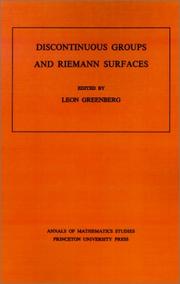
ISBN: 0691081387 1400881641 9780691081380 Year: 1974 Volume: 79 Publisher: Princeton: Princeton university press,
Abstract | Keywords | Export | Availability | Bookmark
 Loading...
Loading...Choose an application
- Reference Manager
- EndNote
- RefWorks (Direct export to RefWorks)
Study 79 contains a collection of papers presented at the Conference on Discontinuous Groups and Ricmann Surfaces at the University of Maryland, May 21-25, 1973. The papers, by leading authorities, deal mainly with Fuchsian and Kleinian groups, Teichmüller spaces, Jacobian varieties, and quasiconformal mappings. These topics are intertwined, representing a common meeting of algebra, geometry, and analysis.
Group theory --- Complex analysis --- Number theory --- RIEMANN SURFACES --- Discontinuous groups --- congresses --- Congresses --- Riemann surfaces --- Congresses. --- Groupes discontinus --- Combinatorial topology --- Functions of complex variables --- Surfaces, Riemann --- Functions --- Abelian variety. --- Adjunction (field theory). --- Affine space. --- Algebraic curve. --- Algebraic structure. --- Analytic function. --- Arithmetic genus. --- Automorphism. --- Bernhard Riemann. --- Boundary (topology). --- Cauchy sequence. --- Cauchy–Schwarz inequality. --- Cayley–Hamilton theorem. --- Closed geodesic. --- Combination. --- Commutative diagram. --- Commutator subgroup. --- Compact Riemann surface. --- Complex dimension. --- Complex manifold. --- Complex multiplication. --- Complex space. --- Complex torus. --- Congruence subgroup. --- Conjugacy class. --- Convex set. --- Cyclic group. --- Degeneracy (mathematics). --- Diagram (category theory). --- Diffeomorphism. --- Differential form. --- Dimension (vector space). --- Disjoint sets. --- E7 (mathematics). --- Endomorphism. --- Equation. --- Equivalence class. --- Euclidean space. --- Existence theorem. --- Existential quantification. --- Finite group. --- Finitely generated group. --- Fuchsian group. --- Fundamental domain. --- Fundamental lemma (Langlands program). --- Fundamental polygon. --- Galois extension. --- Holomorphic function. --- Homeomorphism. --- Homology (mathematics). --- Homomorphism. --- Hurwitz's theorem (number theory). --- Inclusion map. --- Inequality (mathematics). --- Inner automorphism. --- Intersection (set theory). --- Irreducibility (mathematics). --- Isomorphism class. --- Isomorphism theorem. --- Jacobian variety. --- Jordan curve theorem. --- Kleinian group. --- Limit point. --- Mapping class group. --- Metric space. --- Monodromy. --- Monomorphism. --- Möbius transformation. --- Non-Euclidean geometry. --- Orthogonal trajectory. --- Permutation. --- Polynomial. --- Power series. --- Projective variety. --- Quadratic differential. --- Quadric. --- Quasi-projective variety. --- Quasiconformal mapping. --- Quotient space (topology). --- Rectangle. --- Riemann mapping theorem. --- Riemann surface. --- Schwarzian derivative. --- Simply connected space. --- Simultaneous equations. --- Special case. --- Subgroup. --- Subsequence. --- Surjective function. --- Symmetric space. --- Tangent space. --- Teichmüller space. --- Theorem. --- Topological space. --- Topology. --- Uniqueness theorem. --- Unit disk. --- Variable (mathematics). --- Winding number. --- Word problem (mathematics). --- RIEMANN SURFACES - congresses --- Discontinuous groups - Congresses --- Geometrie algebrique --- Fonctions d'une variable complexe --- Surfaces de riemann
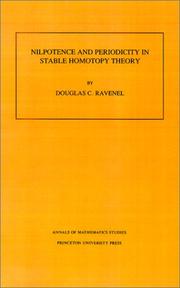
ISBN: 069108792X 069102572X 1400882486 9780691025728 9780691087924 Year: 1992 Volume: 128 Publisher: Princeton (N.J.): Princeton university press,
Abstract | Keywords | Export | Availability | Bookmark
 Loading...
Loading...Choose an application
- Reference Manager
- EndNote
- RefWorks (Direct export to RefWorks)
Nilpotence and Periodicity in Stable Homotopy Theory describes some major advances made in algebraic topology in recent years, centering on the nilpotence and periodicity theorems, which were conjectured by the author in 1977 and proved by Devinatz, Hopkins, and Smith in 1985. During the last ten years a number of significant advances have been made in homotopy theory, and this book fills a real need for an up-to-date text on that topic. Ravenel's first few chapters are written with a general mathematical audience in mind. They survey both the ideas that lead up to the theorems and their applications to homotopy theory. The book begins with some elementary concepts of homotopy theory that are needed to state the problem. This includes such notions as homotopy, homotopy equivalence, CW-complex, and suspension. Next the machinery of complex cobordism, Morava K-theory, and formal group laws in characteristic p are introduced. The latter portion of the book provides specialists with a coherent and rigorous account of the proofs. It includes hitherto unpublished material on the smash product and chromatic convergence theorems and on modular representations of the symmetric group.
Homotopie --- Homotopy theory --- Homotopy theory. --- Deformations, Continuous --- Topology --- Abelian category. --- Abelian group. --- Adams spectral sequence. --- Additive category. --- Affine space. --- Algebra homomorphism. --- Algebraic closure. --- Algebraic structure. --- Algebraic topology (object). --- Algebraic topology. --- Algebraic variety. --- Algebraically closed field. --- Atiyah–Hirzebruch spectral sequence. --- Automorphism. --- Boolean algebra (structure). --- CW complex. --- Canonical map. --- Cantor set. --- Category of topological spaces. --- Category theory. --- Classification theorem. --- Classifying space. --- Cohomology operation. --- Cohomology. --- Cokernel. --- Commutative algebra. --- Commutative ring. --- Complex projective space. --- Complex vector bundle. --- Computation. --- Conjecture. --- Conjugacy class. --- Continuous function. --- Contractible space. --- Coproduct. --- Differentiable manifold. --- Disjoint union. --- Division algebra. --- Equation. --- Explicit formulae (L-function). --- Functor. --- G-module. --- Groupoid. --- Homology (mathematics). --- Homomorphism. --- Homotopy category. --- Homotopy group. --- Homotopy. --- Hopf algebra. --- Hurewicz theorem. --- Inclusion map. --- Infinite product. --- Integer. --- Inverse limit. --- Irreducible representation. --- Isomorphism class. --- K-theory. --- Loop space. --- Mapping cone (homological algebra). --- Mathematical induction. --- Modular representation theory. --- Module (mathematics). --- Monomorphism. --- Moore space. --- Morava K-theory. --- Morphism. --- N-sphere. --- Noetherian ring. --- Noetherian. --- Noncommutative ring. --- Number theory. --- P-adic number. --- Piecewise linear manifold. --- Polynomial ring. --- Polynomial. --- Power series. --- Prime number. --- Principal ideal domain. --- Profinite group. --- Reduced homology. --- Ring (mathematics). --- Ring homomorphism. --- Ring spectrum. --- Simplicial complex. --- Simply connected space. --- Smash product. --- Special case. --- Spectral sequence. --- Steenrod algebra. --- Sub"ient. --- Subalgebra. --- Subcategory. --- Subring. --- Symmetric group. --- Tensor product. --- Theorem. --- Topological space. --- Topology. --- Vector bundle. --- Zariski topology.
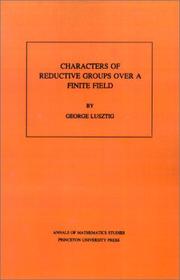
ISBN: 0691083509 0691083517 1400881773 9780691083513 9780691083506 Year: 1984 Volume: 107 Publisher: Princeton (N.J.): Princeton university press,
Abstract | Keywords | Export | Availability | Bookmark
 Loading...
Loading...Choose an application
- Reference Manager
- EndNote
- RefWorks (Direct export to RefWorks)
This book presents a classification of all (complex)irreducible representations of a reductive group withconnected centre, over a finite field. To achieve this,the author uses etale intersection cohomology, anddetailed information on representations of Weylgroups.
512 --- Characters of groups --- Finite fields (Algebra) --- Finite groups --- Groups, Finite --- Group theory --- Modules (Algebra) --- Modular fields (Algebra) --- Algebra, Abstract --- Algebraic fields --- Galois theory --- Characters, Group --- Group characters --- Groups, Characters of --- Representations of groups --- Rings (Algebra) --- Algebra --- 512 Algebra --- Finite groups. --- Characters of groups. --- Addition. --- Algebra representation. --- Algebraic closure. --- Algebraic group. --- Algebraic variety. --- Algebraically closed field. --- Bijection. --- Borel subgroup. --- Cartan subalgebra. --- Character table. --- Character theory. --- Characteristic function (probability theory). --- Characteristic polynomial. --- Class function (algebra). --- Classical group. --- Coefficient. --- Cohomology with compact support. --- Cohomology. --- Combination. --- Complex number. --- Computation. --- Conjugacy class. --- Connected component (graph theory). --- Coxeter group. --- Cyclic group. --- Cyclotomic polynomial. --- David Kazhdan. --- Dense set. --- Derived category. --- Diagram (category theory). --- Dimension. --- Direct sum. --- Disjoint sets. --- Disjoint union. --- E6 (mathematics). --- Eigenvalues and eigenvectors. --- Endomorphism. --- Equivalence class. --- Equivalence relation. --- Existential quantification. --- Explicit formula. --- Explicit formulae (L-function). --- Fiber bundle. --- Finite field. --- Finite group. --- Fourier transform. --- Green's function. --- Group (mathematics). --- Group action. --- Group representation. --- Harish-Chandra. --- Hecke algebra. --- Identity element. --- Integer. --- Irreducible representation. --- Isomorphism class. --- Jordan decomposition. --- Line bundle. --- Linear combination. --- Local system. --- Mathematical induction. --- Maximal torus. --- Module (mathematics). --- Monodromy. --- Morphism. --- Orthonormal basis. --- P-adic number. --- Parametrization. --- Parity (mathematics). --- Partially ordered set. --- Perverse sheaf. --- Pointwise. --- Polynomial. --- Quantity. --- Rational point. --- Reductive group. --- Ree group. --- Schubert variety. --- Scientific notation. --- Semisimple Lie algebra. --- Sheaf (mathematics). --- Simple group. --- Simple module. --- Special case. --- Standard basis. --- Subset. --- Subtraction. --- Summation. --- Surjective function. --- Symmetric group. --- Tensor product. --- Theorem. --- Two-dimensional space. --- Unipotent representation. --- Vector bundle. --- Vector space. --- Verma module. --- Weil conjecture. --- Weyl group. --- Zariski topology.
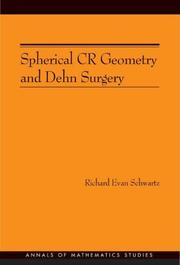
ISBN: 069112809X 1400837197 0691128103 9780691128108 9781400837199 9780691128092 Year: 2007 Publisher: Princeton : Princeton University Press,
Abstract | Keywords | Export | Availability | Bookmark
 Loading...
Loading...Choose an application
- Reference Manager
- EndNote
- RefWorks (Direct export to RefWorks)
This book proves an analogue of William Thurston's celebrated hyperbolic Dehn surgery theorem in the context of complex hyperbolic discrete groups, and then derives two main geometric consequences from it. The first is the construction of large numbers of closed real hyperbolic 3-manifolds which bound complex hyperbolic orbifolds--the only known examples of closed manifolds that simultaneously have these two kinds of geometric structures. The second is a complete understanding of the structure of complex hyperbolic reflection triangle groups in cases where the angle is small. In an accessible and straightforward manner, Richard Evan Schwartz also presents a large amount of useful information on complex hyperbolic geometry and discrete groups. Schwartz relies on elementary proofs and avoids "ations of preexisting technical material as much as possible. For this reason, this book will benefit graduate students seeking entry into this emerging area of research, as well as researchers in allied fields such as Kleinian groups and CR geometry.
CR submanifolds. --- Dehn surgery (Topology). --- Three-manifolds (Topology). --- CR submanifolds --- Dehn surgery (Topology) --- Three-manifolds (Topology) --- Mathematics --- Physical Sciences & Mathematics --- Geometry --- 3-manifolds (Topology) --- Manifolds, Three dimensional (Topology) --- Three-dimensional manifolds (Topology) --- Cauchy-Riemann submanifolds --- Submanifolds, CR --- Low-dimensional topology --- Topological manifolds --- Surgery (Topology) --- Manifolds (Mathematics) --- Arc (geometry). --- Automorphism. --- Ball (mathematics). --- Bijection. --- Bump function. --- CR manifold. --- Calculation. --- Canonical basis. --- Cartesian product. --- Clifford torus. --- Combinatorics. --- Compact space. --- Conjugacy class. --- Connected space. --- Contact geometry. --- Convex cone. --- Convex hull. --- Coprime integers. --- Coset. --- Covering space. --- Dehn surgery. --- Dense set. --- Diagram (category theory). --- Diameter. --- Diffeomorphism. --- Differential geometry of surfaces. --- Discrete group. --- Double coset. --- Eigenvalues and eigenvectors. --- Equation. --- Equivalence class. --- Equivalence relation. --- Euclidean distance. --- Four-dimensional space. --- Function (mathematics). --- Fundamental domain. --- Geometry and topology. --- Geometry. --- Harmonic function. --- Hexagonal tiling. --- Holonomy. --- Homeomorphism. --- Homology (mathematics). --- Homotopy. --- Horosphere. --- Hyperbolic 3-manifold. --- Hyperbolic Dehn surgery. --- Hyperbolic geometry. --- Hyperbolic manifold. --- Hyperbolic space. --- Hyperbolic triangle. --- Hypersurface. --- I0. --- Ideal triangle. --- Intermediate value theorem. --- Intersection (set theory). --- Isometry group. --- Isometry. --- Limit point. --- Limit set. --- Manifold. --- Mathematical induction. --- Metric space. --- Möbius transformation. --- Parameter. --- Parity (mathematics). --- Partial derivative. --- Partition of unity. --- Permutation. --- Polyhedron. --- Projection (linear algebra). --- Projectivization. --- Quotient space (topology). --- R-factor (crystallography). --- Real projective space. --- Right angle. --- Sard's theorem. --- Seifert fiber space. --- Set (mathematics). --- Siegel domain. --- Simply connected space. --- Solid torus. --- Special case. --- Sphere. --- Stereographic projection. --- Subgroup. --- Subsequence. --- Subset. --- Tangent space. --- Tangent vector. --- Tetrahedron. --- Theorem. --- Topology. --- Torus. --- Transversality (mathematics). --- Triangle group. --- Union (set theory). --- Unit disk. --- Unit sphere. --- Unit tangent bundle.
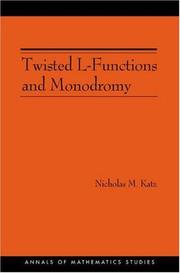
ISBN: 1282820893 9786612820892 1400824885 069109151X 0691091501 9781400824885 9780691091501 9780691091518 9781282820890 6612820896 Year: 2002 Volume: 150 Publisher: Princeton : Princeton University Press,
Abstract | Keywords | Export | Availability | Bookmark
 Loading...
Loading...Choose an application
- Reference Manager
- EndNote
- RefWorks (Direct export to RefWorks)
For hundreds of years, the study of elliptic curves has played a central role in mathematics. The past century in particular has seen huge progress in this study, from Mordell's theorem in 1922 to the work of Wiles and Taylor-Wiles in 1994. Nonetheless, there remain many fundamental questions where we do not even know what sort of answers to expect. This book explores two of them: What is the average rank of elliptic curves, and how does the rank vary in various kinds of families of elliptic curves? Nicholas Katz answers these questions for families of ''big'' twists of elliptic curves in the function field case (with a growing constant field). The monodromy-theoretic methods he develops turn out to apply, still in the function field case, equally well to families of big twists of objects of all sorts, not just to elliptic curves. The leisurely, lucid introduction gives the reader a clear picture of what is known and what is unknown at present, and situates the problems solved in this book within the broader context of the overall study of elliptic curves. The book's technical core makes use of, and explains, various advanced topics ranging from recent results in finite group theory to the machinery of l-adic cohomology and monodromy. Twisted L-Functions and Monodromy is essential reading for anyone interested in number theory and algebraic geometry.
L-functions. --- Monodromy groups. --- Functions, L --- -L-functions. --- Group theory --- -Number theory --- L-functions --- Monodromy groups --- Abelian variety. --- Absolute continuity. --- Addition. --- Affine space. --- Algebraically closed field. --- Ambient space. --- Average. --- Betti number. --- Birch and Swinnerton-Dyer conjecture. --- Blowing up. --- Codimension. --- Coefficient. --- Computation. --- Conjecture. --- Conjugacy class. --- Convolution. --- Critical value. --- Differential geometry of surfaces. --- Dimension (vector space). --- Dimension. --- Direct sum. --- Divisor (algebraic geometry). --- Divisor. --- Eigenvalues and eigenvectors. --- Elliptic curve. --- Equation. --- Equidistribution theorem. --- Existential quantification. --- Factorization. --- Finite field. --- Finite group. --- Finite set. --- Flat map. --- Fourier transform. --- Function field. --- Functional equation. --- Goursat's lemma. --- Ground field. --- Group representation. --- Hyperplane. --- Hypersurface. --- Integer matrix. --- Integer. --- Irreducible component. --- Irreducible polynomial. --- Irreducible representation. --- J-invariant. --- K3 surface. --- L-function. --- Lebesgue measure. --- Lefschetz pencil. --- Level of measurement. --- Lie algebra. --- Limit superior and limit inferior. --- Minimal polynomial (field theory). --- Modular form. --- Monodromy. --- Morphism. --- Numerical analysis. --- Orthogonal group. --- Percentage. --- Polynomial. --- Prime number. --- Probability measure. --- Quadratic function. --- Quantity. --- Quotient space (topology). --- Representation theory. --- Residue field. --- Riemann hypothesis. --- Root of unity. --- Scalar (physics). --- Set (mathematics). --- Sheaf (mathematics). --- Subgroup. --- Summation. --- Symmetric group. --- System of imprimitivity. --- Theorem. --- Trivial representation. --- Zariski topology.
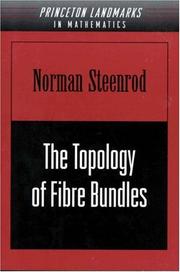
ISBN: 0691080550 0691005486 1400883873 9780691080550 Year: 1951 Volume: 14 Publisher: Princeton (N.J.) : Princeton university press,
Abstract | Keywords | Export | Availability | Bookmark
 Loading...
Loading...Choose an application
- Reference Manager
- EndNote
- RefWorks (Direct export to RefWorks)
Fibre bundles, now an integral part of differential geometry, are also of great importance in modern physics--such as in gauge theory. This book, a succinct introduction to the subject by renown mathematician Norman Steenrod, was the first to present the subject systematically. It begins with a general introduction to bundles, including such topics as differentiable manifolds and covering spaces. The author then provides brief surveys of advanced topics, such as homotopy theory and cohomology theory, before using them to study further properties of fibre bundles. The result is a classic and timeless work of great utility that will appeal to serious mathematicians and theoretical physicists alike.
#WWIS:d.d. Prof. L. Bouckaert/ALTO --- 515.1 --- 515.1 Topology --- Topology --- Topology. --- Analysis situs --- Position analysis --- Rubber-sheet geometry --- Geometry --- Polyhedra --- Set theory --- Algebras, Linear --- Algebraic topology. --- Associated bundle. --- Associative algebra. --- Associative property. --- Atlas (topology). --- Automorphism. --- Axiomatic system. --- Barycentric subdivision. --- Bilinear map. --- Bundle map. --- Classification theorem. --- Coefficient. --- Cohomology ring. --- Cohomology. --- Conjugacy class. --- Connected component (graph theory). --- Connected space. --- Coordinate system. --- Coset. --- Cup product. --- Cyclic group. --- Determinant. --- Differentiable manifold. --- Differential structure. --- Dimension (vector space). --- Direct product. --- Division algebra. --- Equivalence class. --- Equivalence relation. --- Euler number. --- Existence theorem. --- Existential quantification. --- Factorization. --- Fiber bundle. --- Frenet–Serret formulas. --- Gram–Schmidt process. --- Group theory. --- Homeomorphism. --- Homology (mathematics). --- Homomorphism. --- Homotopy group. --- Homotopy. --- Hopf theorem. --- Hurewicz theorem. --- Identity element. --- Inclusion map. --- Inner automorphism. --- Invariant subspace. --- Invertible matrix. --- Jacobian matrix and determinant. --- Klein bottle. --- Lattice of subgroups. --- Lie group. --- Line element. --- Line segment. --- Linear map. --- Linear space (geometry). --- Linear subspace. --- Manifold. --- Mapping cylinder. --- Metric tensor. --- N-sphere. --- Natural topology. --- Octonion. --- Open set. --- Orientability. --- Orthogonal group. --- Orthogonalization. --- Permutation. --- Principal bundle. --- Product topology. --- Quadratic form. --- Quaternion. --- Retract. --- Separable space. --- Set theory. --- Simplicial complex. --- Special case. --- Stiefel manifold. --- Subalgebra. --- Subbase. --- Subgroup. --- Subset. --- Symmetric tensor. --- Tangent bundle. --- Tangent space. --- Tangent vector. --- Tensor field. --- Tensor. --- Theorem. --- Tietze extension theorem. --- Topological group. --- Topological space. --- Transitive relation. --- Transpose. --- Union (set theory). --- Unit sphere. --- Universal bundle. --- Vector field.
| Listing 1 - 10 of 27 | << page >> |
Sort by
|

 Search
Search Feedback
Feedback About UniCat
About UniCat  Help
Help News
News